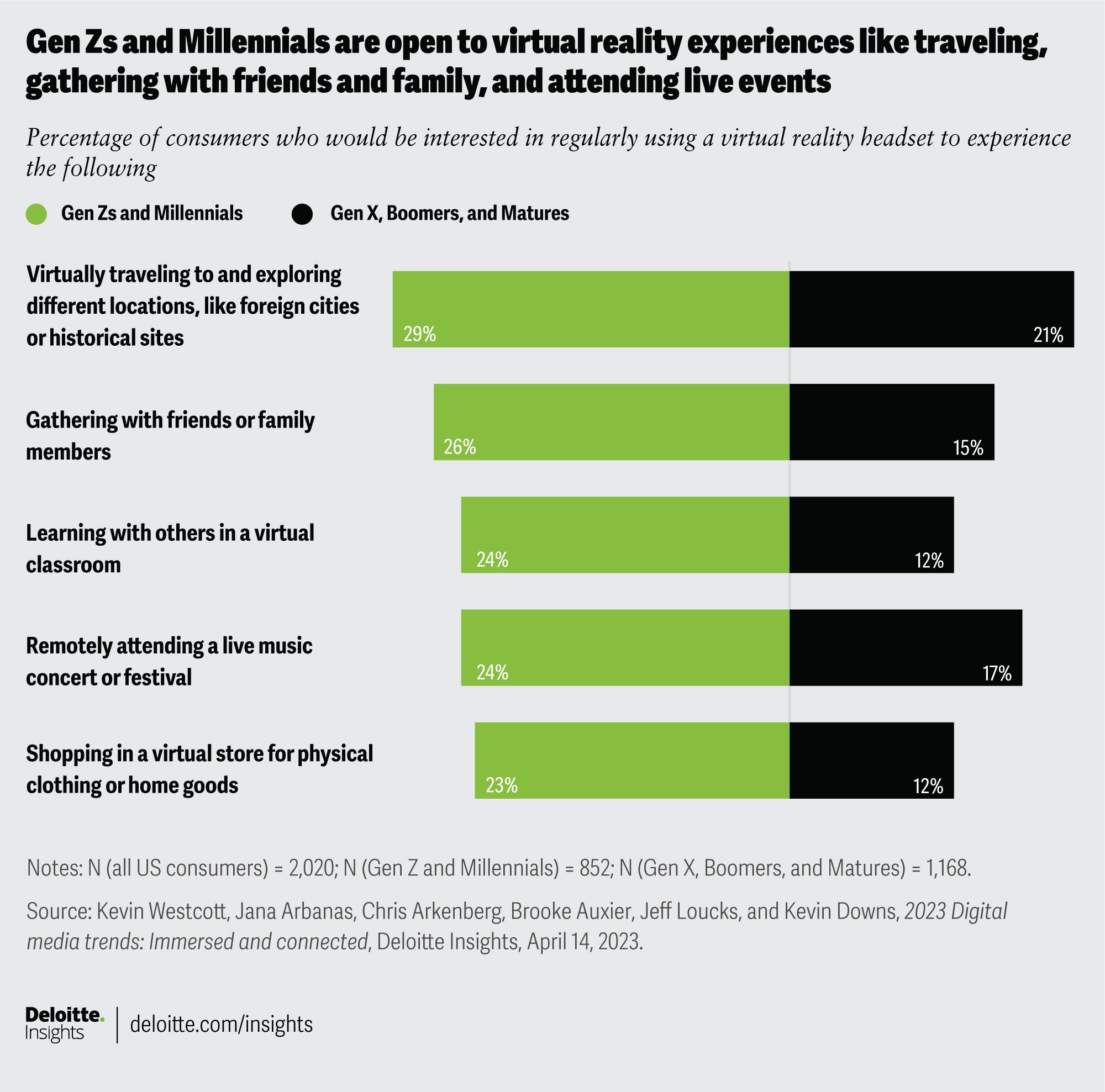While we wait for the metaverse to materialize, young people are already there
Gen Zs and Millennials are stitching together their digital and physical worlds, setting the stage for the next version of reality.

The hype and excitement around the metaverse—and the promise of a unified and coherent platform that will host our digital lives—is still very real. But it may take time to realize fully.1 In the meantime, younger consumers seem to be stitching together fragments of the metaverse with a range of available tools, services, and platforms.
They are using social networks, video games, virtual reality (VR) and augmented reality technologies, and digital currencies and assets to live out digital and virtual experiences that support their relationships, boost their emotional well-being, and offer meaning.
For some, virtual and real worlds are blending—and they’re ready for more.
According to Deloitte’s 2023 Digital media trends study, Gen Zs and Millennials (those aged 14–40) are far more likely than those from older generations to say they would be interested in using a VR headset regularly for at least one experience (out of eight choices). For example, 29% of Gen Zs and Millennials would be interested in using a VR headset to travel and explore virtually, compared to 21% of those 41 and older (see figure).
Many Gen Zs and Millennials are already trying out virtual experiences. Around 40% have used VR technology in some way—from gaming to attending a concert or sporting event, or for work or school. This aligns with our findings around VR headset ownership: About 40% of Gen Z and Millennial respondents say they have a smartphone-based VR headset or a stand-alone VR headset in their homes. As next-generation VR hardware, which offers promises of more immersive and compelling experiences for users, is released, there may be a boost in VR content production and expanded adoption across generations.
The inclination toward VR adoption—of both hardware and experiences—for those under 40 is unsurprising when considering that half of Gen Zs and Millennials surveyed believe online experiences are meaningful replacements for in-person experiences.
Younger people are also engaging in other online activities that offer opportunities for connection. Most Gen Zs and Millennials (75%) are gamers, with many of them playing rich, story-driven games or multiplayer combat games that offer more interactive and immersive experiences.2 A majority of this cohort uses social media as well.3 For Gen Zs and Millennials, experiences in these digital spaces are important for socializing and community building. Close to 50% of Gen Zs and Millennials say they spend more time interacting with others on social media than in real life; similarly, 40% say they spend more time socializing in video games than in real life. VR experiences, most of which are currently single-player and solo endeavors, may need to evolve to become more social to meet the proclivities of these young consumers.4
This cohort is also moving into game worlds to attend other types of events: Nearly a third of Gen Z and Millennial gamers say they have attended a live, non-gaming event in the last year—like a music concert—in a video game world. Among attendees under age 40, nearly 50% purchased digital merchandise during the event, which suggests many in these younger cohorts are willing to spend real money on goods that exist only online. In fact, close to 20% of those under 40 have purchased cryptocurrencies and a smaller share (7%) have purchased nonfungible tokens.
For younger generations, especially digital-native Gen Zs, there seems to be little delineation between “online life” and “real life,” and they are already looking to integrate the two. The path paved by the younger generations, and the behaviors they’re already embracing, could shape the development and refinement of the forthcoming metaverse. As the technology and infrastructure needed to advance the metaverse5 come together, these consumers are expected to lead the way.
Questions to consider
- How can the current behaviors of Gen Zs and Millennials be used to develop new, desirable, and meaningful virtual spaces of the future?
- How can developers and content creators keep community and social elements central to future metaverse and VR experiences to meet the desires of younger generations?
- Is VR technology necessary for the metaverse, or is there another way for users to collaborate in virtual spaces that lowers barriers to entry?